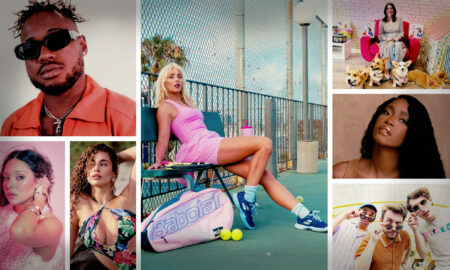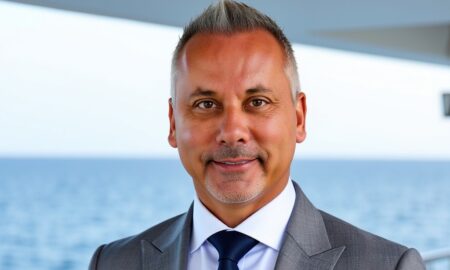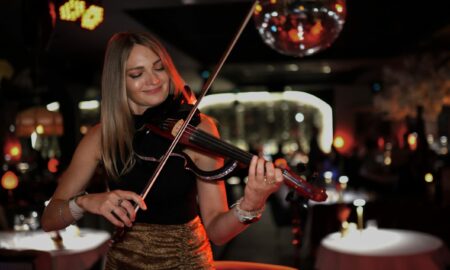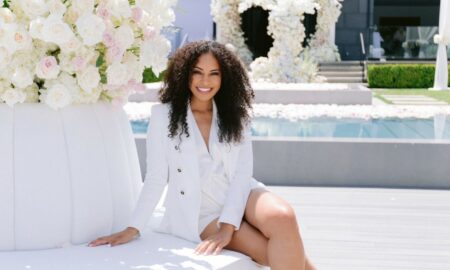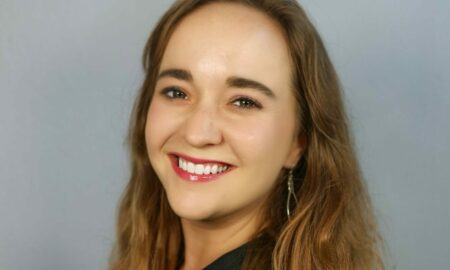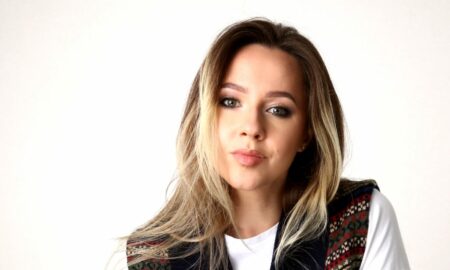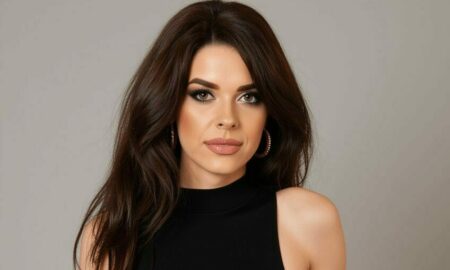

Today we’d like to introduce you to Karim Shuquem.
Karim, let’s start with your story. We’d love to hear how you got started and how the journey has been so far.
I’ve been a teaching artist since 2006. After graduating from my undergrad in 2004, I moved to Chicago to be with my fiancé Elena Brocade (we married in 2009). I sacrificed a few things for that move. I had a well-paid graphic design internship, I was in a popular rock band, I was in the Bay Area paying $300 rent… but I was unhappy and wanted to be with Elena.
Chicago turned out to be an amazing place to grow as an artist. It had two great ingredients: cheap rent and a supportive artist community. Our apartment’s landlord offered us an inexpensive storefront in 2005, and we turned it into an art gallery which we called Reversible Eye. Elena led the refurbishing efforts to rehab the place, then she led most of the logistics and aesthetics regarding the gallery once it was in operation. I became responsible for curation, booking the bands and artists that would fill our space with their creativity.
Having the gallery opened many doors for me. A patron of Reversible Eye told me about The Arts of Life, a non-profit that supports artists with developmental disabilities, and I wanted to check it out. I had volunteered briefly at a similar program called Creative Growth in Oakland and had a taste for the interesting art and perspective in an art studio like this. I was taken immediately by the incredible artwork and the enthusiastic community I found at The Arts of Life. I volunteered for a while, then was hired as studio manager in 2006 and eventually became Artistic Director.
Through the gallery, I was also introduced to Mucca Pazza, a huge theatrical marching band. I became a member for five years. Their nucleus of 20 to 30 musicians and theater people was very supportive and turned me on to writing and receiving grants for my projects. In addition, Mucca members collaborated with me on my personal projects as musicians.
Reversible Eye also led me to meeting the talented film director, Christopher Michael Hefner, who rented our space to film one of his neo-noir surrealist films. He ended up casting me in his next film, and I am forever grateful for that experience. I’ve worn many hats, and I wouldn’t mind wearing the actor hat again if anybody from Hollywood is reading this (haha).
I’ve always been someone to just do stuff. I followed the punk rock ethos of doing things and figuring it out as you go. The benefits of this practice really became clear in the Midwest. I had a long-time dream to have an art gallery, so we took an opportunity and we started one… and that action led to other fascinating opportunities. This was because we took the initiative to do something in the arts community there. There were actually a lot of amazing community-oriented arts groups in Chicago that were inspirational to me.
When Elena’s dad died in 2012, we decided to move home to Los Angeles. It seemed that certain chapters of our lives in Chicago were coming to a close.
We’re always bombarded by how great it is to pursue your passion, etc – but we’ve spoken with enough people to know that it’s not always easy. Overall, would you say things have been easy for you?
It hasn’t been a smooth road, but a series of zig-zagging paths. While in my teens, I saw the way that art and activism came together in punk culture. I started booking local punk shows right after high school. I rented my own club for two months and also was the booker at a bar on Melrose. I made zines and organized animal rights protests. My connections in the fanzine and booking world led to me becoming a performer; I was inspired to start my own band and experience recording as a musician. Eventually, these connections got me hired as keyboardist in an oddball traveling circus variety show created by members of Los Angeles’ prankster group Cacophony Society.
None of this was smooth. It was certainly filled with sublime moments but also plenty of crappy, desperate moments. Just looking at the two years in the circus alone… our first tour was cut short in Virginia, and I almost got arrested for shoplifting food (we were hungry) on the way back to California. Then I had the van drop me off in Oklahoma City, so I could take a bus to Austin to search for a former girlfriend who was said to be spending time there. She wasn’t there. The second tour also ended badly. I was kicked out of the group in New York, then a girlfriend I met in New Orleans came to get me (with her other boyfriend). They offered to drive me to California. We had a great trip filled with adventure as well as tension, ending in a horrible, life-changing car accident in Texas.
When approaching my late 20’s, I decided to go back to school. I had already built up two years of college credits while living between Oakland and L.A. By that time, I had pretty much “followed my bliss.” The only time I think I really faltered with that was my choice to go to graphic design school instead of music school. My family harbored some fear in light of the hard times that I had had with the musician life. They convinced me that my plan to be a music teacher would take several years of study, and that I could simply transfer to a graphics program and be out and working at a job in two years. This sounded logical, and I agreed to do it, but I found I couldn’t hold to the sensible route. While in the design program, I started dabbling with studio art classes. Eventually, I was working towards a BFA in Fine Art as well as a graphic design degree. It took five years for me to finish at Cal State East Bay, and I never did end up becoming a graphic designer.
So, as you know, we’re impressed with Graphic Non-Violence – tell our readers more, for example what you’re most proud of and what sets you apart from others.
There is not one art world; there are several. When I was a kid, my parents would take me to Laguna Beach to walk along the shore and look at paintings of landscapes, portraits, flowers, etc. This is one art world. My Dad also had books on Goya, Picasso, Dali, Miró, and more. That is a different art world. When I was in school, there was a battle between the studio and graphic arts programs, also two different worlds. When we were finding venues for artwork created at The Arts of Life, we would be placed in the “outsider” section at art fairs, and if we were dealing with an established gallery, they would put us in an “outsider” show set aside once a year, reserved for those who are neurodivergent. I didn’t have that type of problem with the Arts of Life band, a music group we created; we had no problem playing with “regular” rock bands at “regular” rock clubs. When it came to the art world, however, curators couldn’t help but place our artists into a box.
When I was being interviewed for grad school, it was suggested, because of my resume, that I join the social practice program. I didn’t want to do that. I was totally down for what they were doing, but I didn’t want to be a “political” artist or a “socially-minded” artist. I just wanted to be an artist. At that time I was making huge drawings of prison architecture. I wanted to talk about the prison industrial complex, racism, capitalism, etc. but I also wanted to talk about human psychology, religion, and personal history at the same time. I didn’t understand all the categories, especially after the disappointment with the art world for not looking at the art of my studio as just art, but as disability art.
For me, I’ve come to see being an artist and being a teacher as intertwined. It was working as a teacher at Arts of Life that pushed me to go further with my own art; it was being socially engaged that gave me inspiration to make art and to share my art. I was able to find crossover between the “fine art” world and the “community art” world.
Art doesn’t need to have such a strong separation between the types of audiences or media that is used. You can make “commercial art” that is socially engaged at the same time as being “fine art.” You can create it with a mixture of multi-media tools, digital tools, traditional tools, and even performative methods.
I’ve recently started a business, Graphic Non-Violence, that seeks to teach and create socially engaged art. We teach art while finding opportunities to discuss social engagement. We make art for non-profits and grassroots organizations while looking for ways to use the educational side of the business to meet these organizations’ needs. I want to ignore the lines set up between the different art worlds and focus on making art that has an impact. I want to give a sense of empowerment to the artists that make the work.
My favorite example of this type of crossover in our new business is the work that we did last Fall with local non-profit Jail Guitar Doors. I had a “political printmaking” workshop coming up and chose to make something for Jail Guitar Doors as my example for the class. They loved it, and we made tee shirts to sell at a fundraising event they had scheduled at John Anson Ford Theater. On top of that, they were interested in showing the work of my students to sell at the event for fundraising. That part of it didn’t pan out, but the idea was very inspirational for me. I find it extremely empowering for the students, especially in these times, to see their artwork being sold for a worthy non-profit. Both things are gratifying: to have someone be interested in what you make and to help a cause you care about. I want to share the empowerment that I feel when my art directly impacts an organization doing good things, so I work with my students to develop art (i.e. logos, tee-shirt designs, etc.). My job is to discover or create these types of opportunities.
Graphic Non-Violence has a couple of regular design clients at the moment. One notable group is Spirit Series out of Santa Monica. They produce inspirational one-act plays with middle school students as a way for them to learn about figures from history such as Harriet Tubman, or Sitting Bull, or Buddha. Also, the way they teach by having the students embody these inspirational figures is pretty amazing. Additionally, we’re working on a tee-shirt design for a program that takes guns from youth no questions asked and gives them a musical instrument instead. I’m working with one of my students on this project.
I am currently teaching more than 20 online art lessons per week, and before the pandemic hit we had a schedule of six workshops per year. We regularly set-up a printmaking station at benefits to share what we do and take donations for the benefit cause. It feels like this business is growing at a good rate, and I’m excited about the future.
So, what’s next? Any big plans?
I’m very excited about Graphic Non-Violence right now. The pandemic may have slowed down the workshops, but I’m doing so much online teaching. It’s really helping me grow as a teacher AND as an artist.
Other than that, I have a big installation coming up in October at Adams Square mini-park in Glendale. I’ll be showing my Die Kunstkammer (diekunstkammer.com) Cabinet of Curiosities, a 100-piece ever-evolving stack of mysterious black boxes.
These two pursuits are taking up most of my time this year.
Graphic Non-Violence Pricing:
- Four person weekly online drawing class (90 minutes) – $12.50 per week
- Postcard of the Month club – $15 per week
- Jail Guitar Doors tee-shirt https://jail-guitar-doors.myshopify.com/products/block-print-tee-shirt-jail-guitar-doors-usa-unisex
Contact Info:
- Address: 314 W. 58th St. #210, Los Angeles CA 90037
- Website: shuquem.com
- Phone: (323) 510-6937
- Email: [email protected]
- Instagram: https://www.instagram.com/karim.shuquem/
- Twitter: https://twitter.com/graphic_nv
- Other: https://www.patreon.com/graphicnonviolence






Image Credit:
Puppet portrait by Michael Serwich
Suggest a story: VoyageLA is built on recommendations from the community; it’s how we uncover hidden gems, so if you or someone you know deserves recognition please let us know here.

